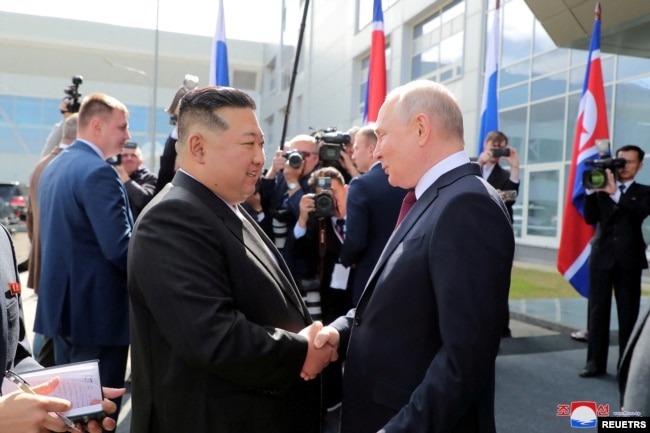North Korean leader Kim Jong Un inspected overhead images of U.S. military facilities in Guam, state media reported Wednesday, hours after claiming the successful launch of his country’s first military spy satellite.
During a visit to a satellite control center in Pyongyang, Kim observed satellite images of Andersen Air Force Base, Apra Harbor and other major U.S. military bases, reported the official Korean Central News Agency, or KCNA.
The report did not include any images allegedly taken by the satellite, launched late Tuesday from the country’s west coast. It said the device would undergo seven to 10 days of “fine-tuning” before formally starting its reconnaissance mission on December 1.
Kim wants to launch “many more” spy satellites and place them “on different orbits,” as part of efforts to better monitor U.S. and allied troops in the region, KCNA reported.
It was North Korea’s third attempted spy satellite launch this year. Previous launches, in May and August, ended in failure because of rocket problems.
South Korea’s military believes the latest attempt successfully placed a satellite into orbit, although it said additional analysis is needed before determining whether the device is operating normally.
The United States and its allies condemned the launch as a provocation and violation of United Nations Security Council resolutions, while quickly arranging shows of military force against Pyongyang.
On Wednesday, a U.S. nuclear-powered submarine, the USS Santa Fe, docked at a South Korean port, according to South Korea’s Navy. A day earlier, the USS Carl Vinson aircraft carrier arrived in the South Korean port city of Busan.
South Korea, the United States, and Japan are engaged in talks on holding a joint maritime drill involving the U.S. aircraft carrier, reported South Korea’s Yonhap news agency.
Earlier, South Korea announced the partial suspension of a 2018 inter-Korean military agreement meant to ease tensions.
A first step
Analysts debate how much useful information North Korea’s spy satellite program will provide. North Korea has not revealed how many satellites it intends to keep in orbit simultaneously. The quality of imagery they will produce is also uncertain.
After retrieving parts of a North Korean spy satellite and space launch vehicle that plunged into the sea in May, South Korea’s military said it assessed that the device “had no military utility” as a reconnaissance satellite.
“However, I think even a satellite with rudimentary capabilities could still be a first step, or could modestly improve North Korea’s situational awareness,” said Tianran Xu, an analyst who focuses on Northeast Asian security and missile systems for the Vienna-based Open Nuclear Network.
North Korea has placed at least two satellites into orbit – the latest in February 2016 – but neither is believed to be working. Pyongyang claimed those launches were part of its peaceful space development program.
The United States and its allies condemned those launches as thinly disguised tests of long-range missile technology. North Korea is banned from any ballistic missile activity under multiple United Nations Security Council resolutions.
Russian help
During a September meeting with North Korean leader Kim Jong Un in Russia’s Far East, Russian President Vladimir Putin appeared to confirm Moscow was helping Pyongyang build satellites.

However, the exact nature of any cooperation remains unclear, since it may be too early for North Korea to have incorporated much of the help, Xu said in an interview with VOA.
“Even if there is some substantial Russian aid coming – either in satellite technology, sensor technology, or in the launch vehicle itself – if it’s that substantial, they may choose to use the knowledge … for their next launch,” Xu added.
A Russian military aircraft flew to Pyongyang on Wednesday, less than a day after North Korea launched the satellite, according to aviation tracking data cited by NK News, a Seoul-based publication that focuses on North Korea.
Russia and North Korea have expanded military and other cooperation in recent months, especially as both countries’ ties with the United States have plummeted.
South Korea response
South Korea, which had repeatedly warned the North against moving ahead with the launch, on Wednesday announced it would resume reconnaissance and surveillance flights along the border with North Korea.
The moves came as part of the partial suspension of the 2018 Comprehensive Military Agreement, or CMA, between Seoul and Pyongyang.
The agreement set up buffer and no-fly zones and banned other military activity along the inter-Korean border. North Korea has repeatedly violated the agreement in recent years.
After it was signed, U.S. military officials in South Korea were publicly supportive of the CMA, saying it was helping to reduce tensions along the border during a period of sensitive diplomacy.
That diplomacy was short-lived, though, and North Korea soon intensified its weapons tests, verbal threats and cross-border provocations.
Some analysts fear that a unilateral South Korea withdrawal from the agreement could lead to misunderstandings and miscalculations, increasing the chances of a clash with North Korea.
Any abrogation of the CMA “will be the result of deteriorated inter-Korea relations and escalatory steps by North Korea, not the cause,” said Sydney Seiler, who until earlier this year was the national intelligence officer for North Korea in the U.S. National Intelligence Council.
“The only question left for Seoul in such a scenario is how to manage the messaging and any domestic political blowback,” Seiler, who is now a senior adviser with the Center for Strategic & International Studies, told VOA.
North Korea has not publicly responded to South Korea’s decision to suspend parts of the CMA.
Earlier Tuesday, a North Korean state media editorial defended the country’s space program as a “war deterrent” that will help promote a “strategic security balance” in the region.
The North Korean editorial, written by an aerospace technology researcher, slammed South Korea’s coming launch as an aggressive and “extremely dangerous” military provocation.
Later this month, South Korea plans to launch its first domestically built spy satellite, using a SpaceX Falcon 9 rocket.
Source: VOA
